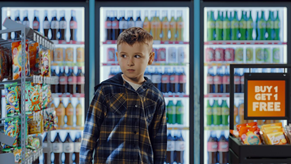New survey indicates reduction in sugar content in energy drinks in response to sugar tax but increase in proportion sold in bigger size

Average decrease of 2 teaspoons of sugar. Some brands still contain between 14 and 17 teaspoons of sugar
- Average decrease of 2 teaspoons of sugar
- Some brands still contain between 14 and 17 teaspoons of sugar
Monday 07 October 2019. A new survey¹ by safefood has revealed that energy drinks manufacturers have reduced sugar content in energy drinks in response to the Sugar Sweetened Drinks Tax, but that there has been an increase in the proportion of drinks being sold in bigger serving sizes. The survey found that the average sugar content per serving of energy drinks has fallen by approximately two level teaspoons of sugar (from 31g in 2015 to 23g in 2019). Of the three leading energy drink brands who have a combined market share of 80%, there was a reduction in the sugar content of the market leader but no reduction in the sugar content of the other two. The survey revealed that before the introduction of the sugar tax, 74% of energy drinks in the Irish market would have been eligible for taxation (i.e. containing at least 5g of sugar per 100ml). The 2019 survey data shows that only 41% are now eligible for taxation.
The snapshot survey by safefood identified an increase in the number of energy drink products for sale (from 39 to 42) with a large increase in drinks sold in 500ml servings (8 in 2015 v 16 in 2019) and no change in the number of drinks sold in 250ml servings.
Commenting on the report, Minister for Health Simon Harris, TD said;
[quote=]I welcome the progress in reformulation by manufacturers since the introduction of the Sugar Sweetened Drinks Tax and it is encouraging to see a significant reduction in sugar content in many products. However, it is disappointing that some of these manufacturers have not responded appropriately. Many of these products are still high in sugar and I strongly urge retailers and manufacturers to consider further measures to reduce the sugar content of their products. I am also very concerned at the trend in increasing container sizes. I call on children, young people and their parents to be aware that these drinks are still unsuitable for consumption by them.[/quote]
Minister of State for Health Promotion and the National Drugs Strategy, Catherine Byrne TD, added; "I welcome the publication of this survey. While I am pleased to see the reduction in sugar content in some energy drinks, it is very disappointing that the number of products on the market and the size of some containers has increased. It is vital that everyone, from retailers and manufacturers to parents and communities, play their part in supporting the goals of our Healthy Ireland Obesity Policy and Action Plan. Our shared priority must be to combat obesity among our young people and improve their health into the future”.
The latest market research² shows that between 2015 and 2018, there was a 3.4% increase in the volume of energy drinks sold in off-trade (i.e. supermarkets, convenience stores and discounters) in Ireland and this now totals 26.7m litres. This is the equivalent of every man, woman and child drinking 5.5 litres of energy drinks every year and puts Ireland near the very top of energy drink consumption relative to other countries in the EU.
Dr Marian O’Reilly, Chief Specialist in Nutrition, safefood continued; “Regular energy drinks are basically sugary drinks with added caffeine and we know that sugary drinks are linked with poor dental health and excess weight. It’s a concern that they are cheap, readily available, in large containers and are marketed in a way that is appealing to young people. It is encouraging to see the fall in the average sugar content of these products. However, this is in contrast to caffeine contents appearing to have increased, with one serving of an energy drink contributing more caffeine than a standard expresso. These drinks are not suitable for children and we would encourage those aged over 16 to consider energy drinks as an occasional drink due to the often-high sugar and caffeine content.”
The survey consisted of a snapshot survey of brands available for sale on island of Ireland during April 2019. It was carried out in major supermarkets, discount and convenience retailers and analysed the nutritional data listed on the products’ own labels. The report “A survey of energy drinks on the island of Ireland – 2019” is available to download from safefood website (www.safefood.eu) along with a poster for schools.
- Ends -




Downloads
For more information or to request an interview, please contact
Wilson Hartnell PR
Clodagh Hogan
Tel: +353 1 669 0030
Mob: +353 87 7746128
Email: [email protected]
safefood
Dermot Moriarty
Mob: +353 86 381 1034
Email: [email protected]
References
¹ A survey of energy drinks on the island of Ireland – 2019 (safefood)
² Euromonitor International - Energy drinks in Ireland 2019
Editor’s notes
- The safefood research was a snapshot survey of brands available for sale on island of Ireland during April 2019.
- The survey was conducted in major supermarkets, discount and convenience retailers.
- Energy drinks were purchased and the nutritional data listed on the product’s own label was analysed.




